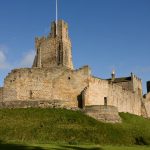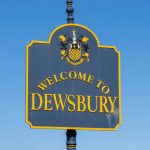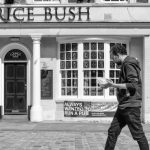
Ulverston is a market town and large civil parish in the South Lakeland district of Cumbria, North West England. Historically in Lancashire, the town is 8 miles northeast of Barrow-in-Furness. It lies just 4 miles from the Lake District, just north of Morecambe Bay and neighbours Swarthmoor, Pennington and Rosside. The town is particularly renowned as the birthplace of Stan Laurel, one-half of the legendary comedy duo Laurel & Hardy. Thus, it is also home to one of the world’s few dedicated Laurel and Hardy Museums. In the 2011 census, the population of Ulverston was recorded as 11,678.
Go to the Cumbria Business Directory
Ulverston – A Fleeting History
The name Ulverston was first recorded in the Domesday Book of 1086 as Ulurestun. The name has two constituents, the first part being either Old Norse; Úlfarr, or Old English; Wulfhere; the second part being Old English; tūn, meaning ‘farmstead’ or ‘village’. Both the words, Úlfarr and Wulfhere have wolf connotations, which explains the presence of a wolf on the town’s coat of arms.
The earliest known history of Ulverston begins around AD 430 when the Saxons took over from the departing Romans. However, with no records in existence, very little is known of the settlement of Ulverston in that period.
Ulverston’s oldest building, the Norman Parish Church of St Mary, was built in 1111. In 1280, the town was granted a Market Charter by King Edward I, which gave authority for a market to be held on Thursdays and an annual fair in September. The market became of great importance to the town, giving it significant growth in both its economy and local status. The granting of the charter event is still celebrated every September during the town’s Charter Festival.
A Prospering Town
Like much of Cumbria in the early 14th century, Ulverston was a constant target of raids by the marauding Scots, under the leadership of Robert the Bruce. However, despite being almost razed to the ground on a couple of occasions by the Scots, Ulverston still managed to prosper.
The Dissolution of the Monasteries, ordered by King Henry VIII, saw nearby Dalton lose its local status when Furness Abbey was destroyed in 1537. Ulverston became the main market centre for the Furness peninsula due to its prime position on local trade routes. In the 1650s, Ulverston became associated with the Quaker movement, as its founder, George Fox, established his base at nearby Swarthmoor Hall.
In 1764, the son of a local tanner, Sir John Barrow (1764 – 1848) was born in the Ulverston hamlet of Dragley Beck. From humble beginnings, the naval administrator and traveller went on to become the Second Secretary to the Admiralty. Essentially, he was charged with running the British Navy.
The Industrialisation of Ulverston
Early industries in the town included tanning, woollen textiles and salt-making. In 1796, the construction of a short canal (1.25 miles) was completed, connecting Ulverston to the sea. This led to a big increase in exports from the town to the rest of the world, especially copper, iron, slate and linens.
In the 1840s, shipbuilding in the town ceased but other industries thrived. This included its tanning yards and an iron foundry at Dragley Beck, as well as an iron & brass foundry in Canal Street. There were also paper and cotton mills at Ellers Mill, a cotton mill at Low Mill, and a linen weaving factory at Stonecross. Ulverston’s industrial success saw the population double across the first half of the 19th century from 3,172 in 1801, to 6,742, by 1851.
Further Development
Furness Railway’s line from Barrow reached Ulverston in 1854. Ulverston & Lancaster Railway, opening in 1857, linked the town to Carnforth and the rest of Lancashire. The arrival of the railway along with the opening of the docks at Barrow in 1867, spelt the beginning of the end of Ulverston Canal as a viable entity, although it didn’t officially close until 1945. Ulverston became an interchange station when the branch line to the Lakes, opened in 1869. It mainly served the ever-increasing numbers of tourists making excursions to Windermere. Accordingly, the availability of tourist accommodation began to expand in town.
Major expansion of industry in the second half of the 19th century, particularly along the canal side, led to the growth of South Ulverston. Samuel Pollitt’s paper mill was established canal side around 1870. Other industries moving there around the same time included; iron and steelworks; chemical and wire works, and expansion of the already established brickworks.
A Star is Born
On 16 June 1890, Arthur Stanley Jefferson was born at his grandparent’s house on the town’s Argyll Street. He was one of five children of Arthur and Margaret Jefferson, an actress from Ulverston. He went on to become Ulverston’s most famous son. A comic actor and director, better known as Stan Laurel (1890 – 1965), he achieved worldwide fame as one-half of the legendary comedy duo ‘Laurel and Hardy’.
The Early 20th Century
The town’s population increased steadily across the late 19th century, rising from 7,414 in 1861 to 10,064 by 1901. However, in the early part of the 20th century, the town’s old-established industries began closing down, eventually being replaced by new enterprises. A factory was built at the site of the canal-side paper mill for servicing aircraft engines during the Second World War, and later for making metal furniture. Glaxo (now GlaxoSmithKline) built a pharmaceutical factory on the old ironworks site in 1948. The Low Mill tannery site was redeveloped as a business park in 1995.
Modern Day Ulverston
Across the 20th century, the population of Ulverston stabilised, standing at only 11,524 in 2001, it had risen less than 15% in 100 years. Ulverston today is a bustling market town and employment centre, serving the Furness Peninsula. The modern-day town has retained much of its old-world charm with its many period houses and a labyrinth of cobbled streets. The marketplace is still very much the hub of the town. There are weekly Thursday and Saturday markets, as well as regular farmers’ markets and food fairs.
Ulverston is known locally as a bit of a party town in reference to the many varied festivals it hosts over the year. One of the most popular events is the ‘Lantern Festival’, which involves hundreds of local residents making their own spectacular lanterns and parading them through the town. The festival culminates with fireworks and a live music event. (see Things to do!)
Ulverston is twinned with the town of Albert in France. The towns hold an annual football match every Easter, alternating the venue between Ulverston and Albert. In July 2016, Ulverston, the birthplace of the legendary comic actor Stan Laurel, was officially twinned with Harlem, Georgia, USA the hometown of Laurel’s screen partner Oliver Hardy. A bronze life-size statue of Laurel and Hardy and a museum dedicated to them can be found in the town.
Getting there!
If you are travelling by car, Ulverston’s principal road link is the A590, which runs to Barrow from Junction 36 of the M6 motorway. It’s about 30 miles between the M6 and Ulverston. The A5087 connects Barrow with Ulverston, via a scenic coastal route.
For train travel, take the Northern Rail, Virgin West Coast, or Trans-Pennine route to Preston or Lancaster and then change to the local service to Barrow-in-Furness. Ulverston is located on the Furness Line from Barrow-in-Furness to Lancaster, ultimately leading on to Manchester Airport. All services are operated by Northern Rail. Ulverston is around 35 mins from Lancaster and 50 mins from Preston. The railway station is a short walk from the town centre.
The town is served by several bus operators. The main service operates between Kendal and Barrow-in-Furness, via Grange over Sands. There are also buses running to Coniston and Newby Bridge. You can change bus at Newby Bridge for Windermere. There’s also a service that only operates between Ulverston and Barrow. National Express buses pass through Ulverston connecting to the rest of the country.
Manchester is the nearest airport to Ulverston. There’s a direct train connection between them.
Places to see!
Hoad Monument
The prominent Hoad Monument was built in 1850 in honour of one of the town’s most renowned citizen’s; Sir John Barrow. It is a replica of an early version of the Eddystone Lighthouse, standing on Hoad Hill. It’s open to the public during the summer. There are great panoramic views of Morecambe Bay and the Lake District from the top of the building.
Ulverston Canal
Ulverston Canal was designed by renowned architect John Rennie, famous. The canal was opened in December 1796. It became known as the shortest, deepest, broadest and straightest canal in England. The canal is now used for leisure purposes, including fishing. A footpath runs between Canal Head on the A590, and Canal Foot on the shores of Morecambe Bay.
Image Credits – Amanda_W – Flicker
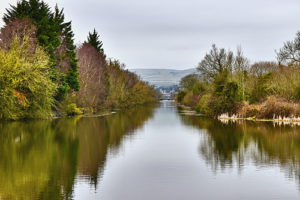
Ulverston Canal
Birkrigg Stone Circle
Birkrigg Stone Circle (aka Druid’s Circle) is a Bronze Age stone circle (circa 1700 – 1440 BC) on Birkrigg Common, overlooking the village of Bardsee, about 2 miles south of Ulverston. The circle consists of two rings of stones, the outer ring about 26 m in diameter and the inner ring 9 m in diameter. The tallest stones are around 900 mm in height.
Things to do In Ulverston!
Laurel & Hardy Museum
The world’s only museum devoted to Laurel and Hardy. The museum, housed in an old cinema, holds a privately owned collection of Laurel and Hardy memorabilia. The duo’s old films and documentaries on their lives are played all day.
Manjushri Kadampa Meditation Centre
If you’ve ever given meditation some thought, then the Manjushri Kadampa Centre could be for you. It’s an internationally renowned centre for meditation, where everyone is welcome. Programmes run throughout the year. You can visit the Buddhist Temple, house or grounds, or take an introductory course to Buddhist meditation. There are also more in-depth courses and a retreat.
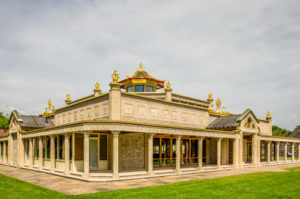
The Buddhist Temple at Manjushri Kadampa
Festivals and Events
The town normally hosts around 30 festivals and events over the year, ranging from 1 day up to 2 weeks in duration. The themes are also widely varied, i.e. from ‘Dickens’ to ‘Buddhism’ and from ‘Laurel and Hardy’ to ‘Gin’. Most events do not have a cover charge.
Where to stay?
There is a good range of places to stay in and around Ulverston. In particular, there’s a good choice in holiday homes, though prices vary markedly depending on occupancy. There are some hotels but the bed and breakfast/guesthouse style accommodation is more prolific. A rough guide to accommodation costs in and around Ulverston are:
Guesthouse/B & B/Lodge: £45 – £75
Hotel: £75 – £100
Holiday home: £30 – £150 pp per night for max occupancy
Banner Credit – Ash Tyson – Flickr – aTantalus!
Why Not Take The Ulverston Quiz?
Quiz Maker – powered by Riddle

